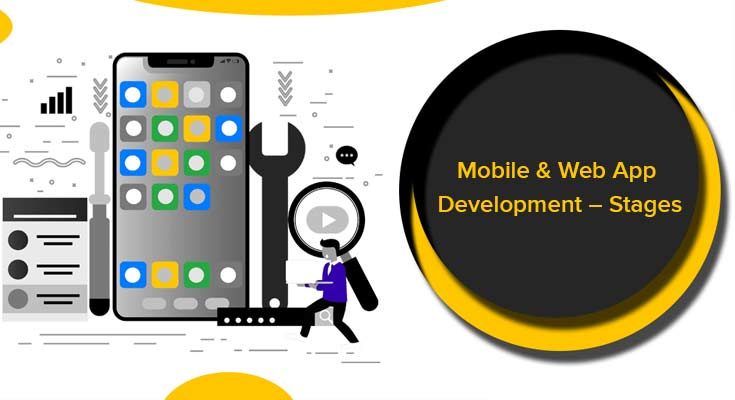Thousands of apps are released every day, capturing the right market is the key. The forecast for the year 2020 says that global mobile app revenue is going to reach around $200 billion. Since about a third of the traffic received is through mobile phones, it is good to start catching the business through mobile phones. Thus the real question that arises is how can you make your app reach milestones and one of the easy ways can be Hire Mobile app Developers.
What cost to build an app? How to build an app? Well, it comes in stages. It always starts with someone’s brilliant idea, and then research. Here we are to help you out in guiding through the different stages of app development. The 8 key steps involved in the process are stated as follows:
1. Getting the idea & Goals:
You need to have a real detailed strategy for your business to work. Everything about the idea and goals of the applications should be clear specially in start up ideas. Any necessary changes can be made later. The mobile app you develop should come handy to the users. The idea should be feasible and it should also be able to solve some genuine problems of the target audience as only then people will get to download the app. There are so many cool app ideas in case you need to search for one, all you need to do is have a look and select according to your goals.
2. Performing research:
The mobile application market is full of apps, thus it is always good to analyze of your competitors work, establish ideas according to the needs that the competitors are not able to sustain so that you can fill into the gap, completing objectives in a timeline. You can scout the app stores for similar applications. You may also get good startup ideas while conducting this research.
3. Infrastructure:
After conducting research, you need to choose from the various technologies available in the market. You need to have proper knowledge of the tools you are going to use, if you don’t, then you need the team that does. This is the point when your question changes from “What is to be made?” to “How are we making it?”
4. Designing and Wire framing:
First thing you need to do is pen down the idea of your application. Try out with explaining your concept to your coworkers or other people and see if they get it. After establishing the feasibility of your product, sorting out the scope and requirements, and making a clear target of a list of features that your app is going to provide, all you need to do is to start experimenting with these things or you can hire top mobile app development company.
Designing includes visualizing the layout of the screen, i.e, placement of buttons, banners, icons, and other elements. The primary objectives are needed to be maintained as the user should not get lost while using the application. Moreover, it focuses on building unique UI without compromising any sort of experience for users. Experimenting with UI sometimes help in making it more feasible for users.
5. Development in phases:
Developers prefer to build the app from scratch, some platforms offer to make prototypes easily to begin the work. So, before deploying the app on app stores, mobile app development consists of multiple phases.
- Alpha Phase:
In the alpha phase, only the core functionality is addressed. The app can barely perform tasks and have plenty of bugs and glitches. However, this phase gives a rough idea as to how the app is going to look and perform.
- Beta Phase:
During the beta phase, the majority of the functions are developed, the app needs testing so that the remaining fixes can be identified. At this stage, the app is released out to specific users to carry out further testing of the product.
- Release Phase:
After several rounds of testing, the app is finally released. Almost every bug is fixed from the developer point of view the customers can now use the service.
6. Testing in Phases:
Testing is one of the never-ending processes, no matter how much you do it, you can never ensure it is fail proof. The aim should be to make it seamless, something that worked well in beta phase might not work that well in the release phase. In startup ideas, the app should be made by taking care of mobile app development security. So, there are various steps of tests that are conducted to ensure quality.
- Testing Functions:
All functions of the app should work properly as if they don’t then the objective of the app is itself not met.
- Testing Performance:
The app should perform tasks in the least possible response time.
- Testing Usability:
Navigation through the app should be easy for any new user so that they do not get confused.
- Testing specifically for a device:
Trying app in various screen sizes and different OS helps to ensure the feasibility of the app. You can prefer using some tools, as well as hands-on testing.
- Testing User Acceptance:
Getting feedback from beta testers can help you know the acceptance of your app.
7. Launching Product:
All the efforts, time, energy, and hard work payout when you launch your app. The primary goal now is to get it downloaded by a good amount of users. Along with the organic reach, you need to boost up your app downloads by using your social media platforms.
It is good to have a website for your app apart from having it only on the play store and the app store, the link to the website can be linked with the description on app stores. You can invite selected people to pre-launch beta testing and provide them with good service. This might help out in ensuring a good amount of downloads once it is released.
8.b Post-Launch:
After the successful app launch, you can’t just sit. You need to do post-launch monitoring, market analysis, build updates for your app. Along with this, you need to check out reviews, fix problems faced by customers. Doing this, help you in making your product better.
Conclusion:
It is not rocket science to develop and run a mobile application these days. Making it successful is one of the big things. It requires proper pre-planning, beta testing, deployment and regular maintenance. Increasing sales becomes easier with the help of these applications. We hope that your application works out well.



